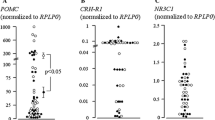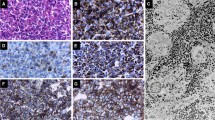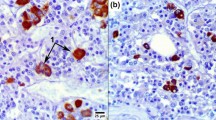Abstract
We observed the histopathological and physiological characteristics of adrenocorticotropic hormone (ACTH)-secreting adenoma cells derived from a rapidly growing pituitary adenoma, which have firm cell attachment and well-preserved hormonal function in a relatively longterm culture. Corticotrophs, obtained from a 43-year-old woman with Cushing's disease in whom plasma ACTH levels increased in response to 1-deamino-8-D-arginine vasopressin (DDAVP) stimulation and the proliferative potential was very high, were grown in tissue culture for up to 6 months. The morphological features were observed by phase contrast and electron microscopy. The cultured cells were incubated with corticotroph-releasing hormone (CRH), arginine vasopressin (AVP), or DDAVP, and ACTH in the medium was measured by radioimmunoassay (RIA). The morphology of the ACTH-secreting adenoma cells in culture revealed a mixed population of formed clusters and spindle-shaped fibroblast-like cells. The adenoma cells were immunohistochemically positive only for ACTH. On electron microscopic observation, pituitary tumor cells obtained 6 days after seeding demonstrated many secretory granules, well-developed rough endoplasmic reticulum, and mitochondria; fewer secretory granules were observed after cultivation for 24 days. ACTH levels in the incubation media were elevated with stimulation by DDAVP, AVP, or CRH. In this study, the establishment of relatively longterm culture of human pituitary adenoma cells seemed to be due to the high proliferative potential of this adenoma. This in vitro study may imply that DDAVP as well as AVP directly stimulates ACTH release from corticotropic adenoma cells.
Similar content being viewed by others
References
Kletzky OA, Marrs RP, Rundall TT, et al (1980) Monolayer and suspension culture of human prolactin-secreting pituitary adenoma. Am J Obstet Gynecol 138:660–664
Kohler PO, Bridson WE, Rayford PL, et al (1969) Hormone production by human pituitary adenomas in culture. Metabolism 18:782–788
Malerbi DA, Mendonca BB, Liberman B, et al (1993) The desmopressin stimulation test in the differential diagnosis of Cushing's syndrome. Clin Endocrinol 38:463–472
Baertschi AJ, Friedli M (1985) A novel type of vasopressin receptor on anterior pituitary corticotrophs? Endocrinology 116:499–502
Colombo P, Passini E, Re T, et al (1997) Effect of desmopressin on ACTH and cortisol secretion in states of ACTH excess. Clin Endocrinol 46:661–668
Dahia PLM, Ahmed-Shuaib A, Jacobs RA, et al (1996) Vasopressin receptor expression and mutation analysis in corticotropin-secreting tumors. J Clin Endocrinol Metab 81:1768–1771
Sawyer WH, Acosta M, Ballaspiri L, et al (1974) Structural changes in the arigine vasopressin molecule that enhance antidiuretic activity and specificity. Endocrinology 94:1106–1115
Sakai Y, Horiba N, Tozawa F, et al (1997) Desmopressin stimulation test for diagnosis of ACTH-dependent Cushing's syndrome Endocrinol J 44:687–695
Kabuto M, Kubota T, Kobayashi H, et al (1993) Modified procedure of monolayer culture of human pituitary adenoma cells on microporous membrane coated with extracellular matrix. Neurol Res 15:304–309
Key G, Becker MHG, Baron B, et al (1993) New Ki-67-equivalent murine monoclonal antibodies (MIB1-3) generated against bacterially expressed parts of the Ki-67 cDNA containing three 62 base pair repetitive elements encoding for the Ki-67 epitope. Lab Invest 68:629–639
Abe T, Sanno N, Osamura RY, et al (1997) Proliferative potential in pituitary adenomas: measurement by monoclonal antibody MIB-1. Acta Neurochir (Wien) 139:613–618
Onda K, Davis RL, Shibuya M, et al (1994) Correlation between the bromodeoxyuridine labeling index and the MIB-1 and Ki-67 proliferating cell indices in cerebral gliomas. Cancer 74:1921–1926
Thibonnier M, Auzan C, Madhun Z, et al (1994) Molecular cloning, sequencing and functional expression of a cDNA encoding the human V1a vasopressin receptor. J Biol Chem 269:3304–3310
Birnbaumer M, Seibold A, Gilbert S, et al (1992) Molecular cloning of the receptor for human antidiuretic hormone. Nature (Lond) 357:333–335
De Keyzer Y, Auzen C, Lenne F, et al (1994) Cloning and functional expression of human V3 pituitary vasopressin receptor. FEBS Lett 356:215–220
Sugimoto T, Saito M, Mochizuki S, et al (1994) Molecular cloning and functional expression of a cDNA encoding the human V1b vasopressin recepton. J Biol Chem 269:27088–27092
Aizawa T, Yasuda N, Greer MA, et al (1982) In vivo adrenocorti-cotropin-releasing activity of neurohypophyseal hormones and their analogs. Endocrinology 110:98–104
Malerbi DA, Fragoso MCBV, Filho AHGV, et al (1996) Cortisol and adrenocorticotropin response to desmopressin in women with Cushing's disease compared with depressive illness. J Clin Endocrinol Metab 81:2233–2237
Newell-Price J, Perry L, Medbak S, et al (1997) A combined test using desmopressin and corticotropin-releasing hormone in the differential diagnosis of Cushing's syndrome. J Clin Endocrinol Metab 82:176–181
Author information
Authors and Affiliations
Corresponding author
Rights and permissions
About this article
Cite this article
Abe, T., Tachikawa, T., Sasaki, A. et al. Histopathological and physiological characteristics of cultured human ACTH-secreting cells derived from a rapidly growing pituitary adenoma. Brain Tumor Pathol 17, 133–138 (2000). https://doi.org/10.1007/BF02484284
Received:
Accepted:
Issue Date:
DOI: https://doi.org/10.1007/BF02484284




